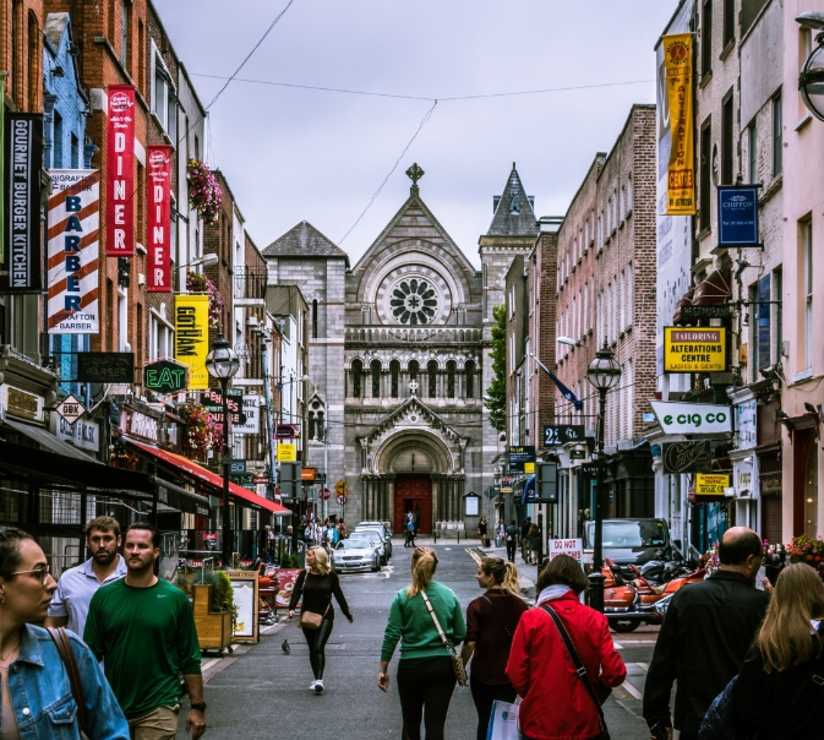Our private tour of Dublin with Jose Luis was absolutely fantastic. He was an excellent guide who truly brought the city's history to life.Elena, Dublin, 2025
Table Of Contents
- You Haven’t Really Done Dublin Without These Four Things
- The Must-Sees: Do Them the Local Way
- The Food That Defines Dublin: Beyond the Stereotypes
- Dublin’s Overrated Tourist Traps: What to Do Instead
- Dublin's Living Culture: Beyond the Museums
- Neighborhood Explorations: Where Dublin Lives
- Interest-Based Dublin: Activities for Every Type of Traveler
- Getting Around Dublin: Transport That Works
- Seasonal Dublin: When to Visit and What to Expect
- Frequently Asked Questions on Things to Do In Dublin
- Your Dublin Adventure: Final Thoughts From a Local
Right, listen up. I’m Aoife Brennan, born and raised in this mad, beautiful city for 35 years. Last week I watched a group pay twelve euros for a pint they could have had for half the price three streets away. Broke my heart. They left thinking they had seen Dublin.
I’m tired of visitors getting steered toward overpriced traps while the real Dublin, the one we actually live in, hums away just out of sight. When people ask me how to explore Dublin, I don’t hand them a polished brochure. I tell them the truth about the Dublin experiences that show the city’s soul.
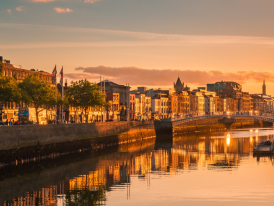
Dublin city centre streets with Georgian buildings and River Liffey in view
Here’s what those glossy guides never mention. Dublin is not just another box-ticking European capital where you queue for selfies and call it culture. This is a city that will chat your ear off, pour you the perfect pint, and argue politics with you until closing time. We have a thousand years of stories crammed into streets you can cross in twenty minutes. The real magic often hides between the so-called must-sees.
When I’m not working as a freelance copyeditor, I’m showing visitors the real Dublin through my City Unscripted experiences. Most days, I watch this city from my sunny Clontarf kitchen window, then take people to the corners that matter. Trust me, I know which stories are worth your time and which ones are just tourist theater.

Lively Dublin pub serving pints and having fun
You Haven’t Really Done Dublin Without These Four Things
Now, before we get into the tourist board stuff, let me tell you what counts. These aren’t just attractions. They’re experiences that show you what makes Dublin tick. All are close enough to walk or a quick DART ride away.
A Proper Pint: And I Mean Proper
Ah, here comes the Guinness chat, you’re thinking. But this isn’t about some tourist pub charging €8 for a rushed pour. It’s about the ritual, the patience, the moment you see why Dubliners fuss over stout.
A real pint takes 119.5 seconds to settle. Watch the cream fall, then wait. Touch it early, and any decent barman will give you the look. I’ve stepped in to correct enough bad Guinness pours to call it a civic duty.
My spot? The Gravediggers in Glasnevin, officially Kavanagh’s, though nobody calls it that. If you’re looking for authentic things to do in Dublin, a local pub like this is a must. The barman still draws shamrocks in the foam, not for show, just because. The walls hold more secrets than a confessional. Next door, Glasnevin Cemetery holds Irish history in stone, with Daniel O’Connell and Michael Collins among them.

A proper pint of Guinness poured in a traditional Dublin pub setting
And yes, Guinness tastes different here. It’s the pipes, the pressure, the fact it hasn’t traveled halfway across the world. Do the polished version at the Guinness Storehouse, grab the view from the Gravity Bar, then head to a neighborhood pub to compare. That pint teaches patience before you taste it.
Not Sure Where to Start in Dublin?
A local can shape the day around what matters most to you..
Traditional Irish Music: The Real Deal
Forget what you think you know about Irish music. If “Danny Boy” or “Whiskey in the Jar” blares from speakers, you’re in the wrong place. Real traditional Irish music happens when players who learned tunes from their grandparents sit down and speak without words.
Sessions at The Cobblestone in Smithfield are sacred. They’re not shows. They’re conversations between fiddles, flutes, and bodhráns that have been going on for generations. Arrive early, buy the musicians a drink, and let the sound carry you.

Traditional Irish music session in a cozy Dublin pub with fiddles and flutes
Etiquette matters. Keep your voice down, clap at the end, and never shout requests. For another classic, try O’Donoghue’s when the regulars gather. For modern gigs, head to Whelan’s once you’ve had your fill of tradition.
Catch a real session and you’ll see why we guard it. This isn’t entertainment. It’s our DNA.
Phoenix Park at the Right Time
People love saying Phoenix Park is one of Europe’s largest enclosed parks. That’s not the point. It’s the city’s lungs, the space that lets Dublin breathe.
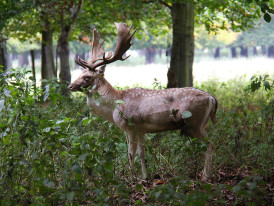
Wild deer in Phoenix Park Dublin with open green fields in view
People love saying Phoenix Park is one of Europe’s largest enclosed parks. That’s not the point. It’s the city’s lungs, the space that lets Dublin breathe.
Skip Dublin Zoo unless you’ve got kids under ten. Walk the Fifteen Acres at golden hour when the light hits the Wellington Monument and the whole city stretches out behind you. The wild deer are everywhere, wearing that judgmental look Dubliners have mastered.
Locals head here for walks, runs, or just breathing space. Catch it on a misty morning when the Dublin Mountains show themselves, and you’ll understand why this park means so much to the city.
Dublin Bay’s Coastal Magic
Here is what makes Dublin, Ireland, special. We are a capital city with a proper seaside only a short DART ride away. Dublin Bay is not just about views, though they are stunning. It offers incredible scenery, where locals are reminded that we are an island nation, not just another European city. It is the Emerald Isle in all its glory.

Dublin Bay cliff path near Howth with sea views and rugged headland
I am biased toward the northside from Clontarf, but the whole Dublin Bay coastline is spectacular. Take the DART to Howth and make the train part of the trip, watching gulls swoop along the line as Dublin fades into the coastline. Walk the cliff path if you have the legs. If not, sit in the harbor with fish and chips and watch the boats.
Feeling brave? Swim at the Forty Foot in Sandycove, famous for its freezing waters and eccentric regulars. The water is cold year-round, so make sure you are prepared and comfortable with cold-water swimming. Or join us at the Bull Wall for another invigorating dip. For easy outdoor adventure in County Dublin, Dublin Bay is the answer.
Looking for a Private City Experience in Dublin?
Explore the city with a local who plans a private day just for you; no groups, no scripts.
The Must-Sees: Do Them the Local Way
Every guide trots out the same big attractions. Most miss the point. Here is how to see Dublin’s big names the way locals do, so they feel real rather than rushed. If you are looking to experience true Irish pubs, wander beyond Temple Bar into quieter neighborhoods for pints with more character and fewer tourists. Famous places like Trinity College and St. Patrick’s Cathedral are must-sees, but leave time for the lesser-known gems where the city’s soul lives. If you are making a short list of things to do in Dublin, do the big names the local way and leave time for the corners in between.
National Leprechaun Museum: A Fun Twist on Irish Folklore
For a quirky take on Irish folklore, go to the National Leprechaun Museum. It is playful and a bit cheeky, the kind of place that doesn’t take itself too seriously while shining a light on Ireland’s myths and legends. Curious about leprechauns or the old Irish folk tales we grew up hearing? The museum’s interactive exhibits make it easy to dive in and come out smiling, all in under an hour.
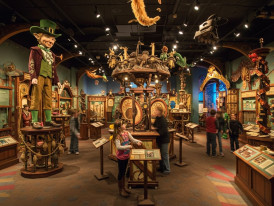
Colorful exhibit at the National Leprechaun Museum in Dublin Ireland
Trinity College: Skip the Crowds, Find the Magic
Trinity College is gorgeous. The Book of Kells is a famous medieval manuscript, and the Old Library Long Room feels like stepping into a story. What the tour groups miss is the quiet. The real magic lives in smaller courtyards where today’s students still study under the same trees that once shaded famous figures like Oscar Wilde and Samuel Beckett, two pillars of Irish literature.

Trinity College Dublin Old Library Long Room with high wooden bookshelves
Here’s what matters right now. The Old Library and the Book of Kells remain open through the end of 2025, while the new Book of Kells Experience runs in the Printing House. Routes and access shift with the renovations, so check Trinity’s site before you go.
Skip the scrum at the main gate and slip in from Nassau Street. You’ll land in Parliament Square, which feels like a university first and a tourist attraction second. Do the Book of Kells early or late afternoon to avoid the lines. And if you want real insight, the student-led tours are short, sharp, and refreshingly honest.
The real secret? Some of the loveliest parts of Trinity are free. Wander the quads, admire the architecture, and let the city go quiet for a minute. In the middle of Dublin, you get a kind of time travel without spending a cent.
Guinness Storehouse: Yes, It’s Touristy, But…
I can already hear you rolling your eyes. “The Guinness Storehouse? That tourist trap?” And yes, it is a tourist magnet. But here is the truth: it is worth it with the right mindset.
The seven-story museum tells the story of Dublin’s most famous export with real energy, not just marketing gloss. You learn the brewing process, the brand’s fascinating history, and how Guinness became a cultural touchstone for Dublin and beyond.
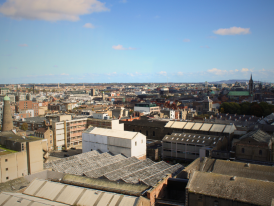
Panoramic view over Dublin city from the Guinness Storehouse
Then there is the Gravity Bar. Some dismiss it as a gimmick, but the view is one of the best in the city. You see Dublin spread out like a map, the River Liffey cutting through the center. On a clear day, you spot the Dublin Mountains and even catch a glimpse of Clontarf across the bay.
Timing is everything. Go on a weekday between two and four in the afternoon for smaller crowds and faster service. Book online to skip the queues. And yes, there is something about that pint at the top. The pipes, the pressure, and the view make it taste a little better.
Curious What You Won’t Find Online in Dublin?
Discover the side only locals talk about.
Dublin Castle: More Than Just State Rooms
I know, velvet ropes and photo ops can make Dublin Castle sound like homework. It is not. This place is a crash course in fascinating history with layers you will not get from a brochure.
Start with the State Apartments if that is your thing, but the real magic is what most tours skip. Guided tours take you under the Viking defenses and the foundations of medieval Dublin. Step into the Chapel Royal to see carved coats of arms, then circle the Record Tower and Dubh Linn Garden, where the castle got its name. For a deeper look at the city’s past, pop into Dublin City Hall next door for the free “The Story of the Capital” exhibition, a heritage center-style overview of Dublin’s civic history and identity.

Dublin Castle courtyard with the Record Tower and stone walls
Now the best part. Slip into the Chester Beatty Library next door, now just called “Chester Beatty.” It is world-class and free, a treasure trove of manuscripts and artifacts that make the pomp upstairs feel small. If exhibitions are on, the Coach House Gallery in the garden is a quick add. You have just gone from court theater to real substance in ten minutes.
Timing matters. Book guided tours for mid or late afternoon to avoid crowds, then wander to the Liberties for Patrick’s Cathedral if you still have energy. Dublin Castle earns its famous landmarks tag because the city’s story plays out on the surface and beneath your feet.
St. Patrick’s Cathedral: Ireland in Stone
St. Patrick’s Cathedral is Ireland’s history in stone, standing for more than 800 years. Jonathan Swift, a giant of Irish literature, was Dean from 1713 to 1745 and is buried here beside Esther “Stella” Johnson.
It sits in the Liberties, Dublin’s oldest quarter, where medieval Dublin still shows in the streets. Do a short guided tour or use an audio guide.
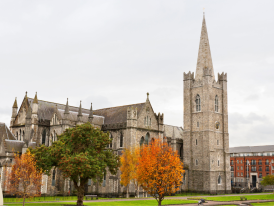
St. Patrick’s Cathedral Dublin in Fall
Walk the nave, read a plaque, then step out to Patrick Street and the markets. This is working Dublin, not a postcard. If it rains or you want more Irish history, head to Dublin Castle and the free Chester Beatty Library next door.
Locals call it Patrick’s Cathedral. Take your time and walk the aisles. The folklore about Swift’s ghost fits, but the facts are enough.
Temple Bar: Let’s Be Honest About This
Ah, Temple Bar. Every Dubliner has complicated feelings about it, like an embarrassing relative.
Is it expensive? Yes. Packed with tourists taking selfies? Also yes. But it exists for a reason. The area keeps a rare medieval Dublin street pattern, and those cobbled streets in every photo are real, not a film set.
If you want culture over pub crawls, head for the institutions. The Irish Film Institute screens restorations and indie films and houses the Irish Film Archive. The Project Arts Centre runs theater, dance, and visual art nearby. In Meeting House Square, the National Photographic Archive shows rotating exhibitions from the National Library’s collection.
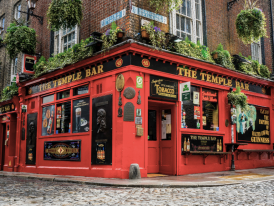
Temple Bar Dublin pub exterior with cobbled street
You will hear plenty of music in Temple Bar pubs, but much of it is for visitors. For traditional Irish music that feels like a conversation, walk to pubs across the river or in nearby streets where the sessions come first.
My advice? Do Temple Bar once. Take the photos, have a drink, then slip into the surrounding streets for traditional music sessions and a real feel of Dublin at night with normal prices and a slower pace.
A proper Irish breakfast is more than food.
The Food That Defines Dublin: Beyond the Stereotypes
Dublin’s food scene has grown fast in recent years, but we have not forgotten our roots. If you are wondering what to eat in Dublin, here is what locals actually order and where you will find it.
The Irish Breakfast: Done Properly
A proper Irish breakfast is more than food. It is a morning ritual that ties you to generations before you. A typical plate would have bacon rashers, sausages, eggs, black pudding, sometimes tomatoes, mushrooms, beans, and soda or brown bread with plenty of tea to wash it down.
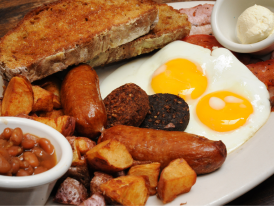
Irish breakfast served in a Dublin café with coffee
Queen of Tarts on Dame Street serves breakfast with care in a cozy spot close to the city center. For a modern take that keeps the tradition, Brother Hubbard bakes its own bread and sources everything from Irish producers across its Dublin cafés.
The real secret is sourcing. Good Irish butter, free-range eggs, and black pudding from butchers with the Bord Bia quality mark. Get those basics right, and you will see why Dubliners fuss about breakfast before the day has even begun.
Dublin Bay: Seafood Done Right
For years, we drowned good seafood in cream and called it fancy. That has changed. I order langoustines, Nephrops norvegicus if you want to be posh, sweet and delicate, needing nothing more than lemon and a bit of salt.
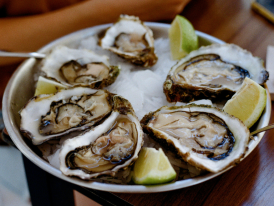
Dublin Bay oysters and lemon on ice
The Seafood Café on Fownes Street Upper keeps it simple and super fresh, the spiritual successor to his much-missed Klaw crab shack. Expect fast-shucked oysters and seafood that tastes like the sea, not the sauce. If you see his Salty Buoy truck around town, grab a roll and thank me later.
For a view, The Winding Stair looks across the River Liffey to the Ha’penny Bridge, a bookish Dublin landmark that still knows how to treat a piece of fish properly.
Modern Irish Cuisine: We’ve Learned to Cook
Dublin’s kitchens stopped hiding Irish ingredients under French sauces. We grow world-class beef, lamb, vegetables, dairy, and seafood. It was only a matter of time before chefs let the produce speak for itself.
Chapter One earned Michelin stars by trusting Irish ingredients and serious technique. It is not cheap, but every dish proves you can find new flavors in food you thought you knew.

Modern Irish dish in a restaurant, with seasonal vegetables
For two-star refinement, Restaurant Patrick Guilbaud brings Irish produce with classic French polish. Think farmhouse ingredients meeting precise technique.
If you want the same ethos for less, plenty of smaller rooms now cook seasonally and source from local farms. They let butter, vegetables, and fish taste like themselves. That is the point of modern Irish cooking: quality over flash.
Hungry to Taste Dublin Like a Local?
From tucked-away eateries to lively markets, discover flavors worth your time.
Pub Food: Comfort Done Right
Good pub food is comfort that does not apologize for itself. If you are wondering what to eat in Dublin, think Irish stew made with lamb from Irish fields, shepherd’s pie with proper potatoes on top, and fish and chips with freshly landed fish. Some menus call it Guinness stew, where the gravy is dark with stout, exactly what you want on a wet evening in Dublin city.
The Brazen Head claims to be Dublin’s oldest pub, with 1198 over the door. Believe the folklore if you like. The bowls are hot and honest, and that is what matters.
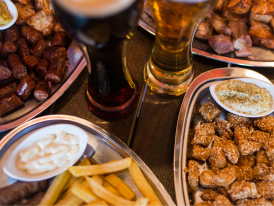
Proper Irish pub food to share with a pint or two
For fish and chips, visitors line up at Leo Burdock, established in 1913, while locals nudge you toward Beshoff for a simpler, good-value box. I rotate between the two, then head to Howth for a harbor feed after a cliff walk when the weather plays nice.
If you want a real traditional pub experience, head outside the city to Johnnie Fox’s Pub in Glencullen. It is about a 30-minute drive from central Dublin, so plan a slightly longer, scenic run into the hills. The lively atmosphere and solid Irish food make it worth the trip.
Irish Whiskey Museum and Whiskey Tastings in Dublin
The Irish Whiskey Museum on Grafton Street gives a quick primer on Irish whiskey with themed tastings that help you tell your pot still from your blend, no snobbery involved. In the Liberties, Teeling Whiskey Distillery is Dublin’s first new distillery in more than 125 years, honoring tradition while pushing boundaries.
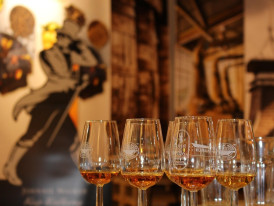
Irish whiskey tasting glasses on a wooden bar in Dublin
For whiskey with personality, try traditional pubs like The Palace Bar, where the shelves read like a mini history of Irish distilling. Or head to L. Mulligan Grocer, where staff guide you toward what you will actually enjoy.
When I am working ghost tours, I often end up in whiskey bars because, to be honest, ghost stories and good whiskey go together like Dublin and rain.
Coffee Culture: Finally Here
Dublin’s coffee scene has moved far past instant and chain-store mediocrity. Local roasters like Proper Order Coffee and Cloud Picker know great coffee needs careful sourcing, proper roasting, and baristas who take it seriously.
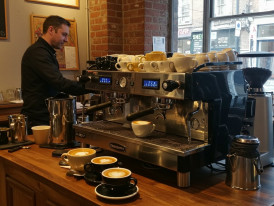
Specialty coffee cups and espresso machine in a Dublin café
I have tried every coffee shop between Clontarf and the city center. 3fe, short for Third Floor Espresso, serves serious coffee without fuss. Vice Coffee pours excellent brews in a space that feels properly Dublin, friendly and unpretentious, focused on quality rather than Instagram likes.
We are still learning, but we are learning fast.
What If Your Day in Dublin Was Planned by Someone Who Knows It, and You?
City Unscripted matches you with a local host who creates a private experience based on your interests, not a set route.
Dublin’s Overrated Tourist Traps: What to Do Instead
Every city has attractions that promise more than they deliver. In a city this compact, wasting time stings. Here’s what to skip, tweak, or replace.
Grafton Street: Shopping Street Mediocrity
Grafton Street is hyped as a must-see for shopping, but it feels generic with international chains. Street performers and the evening buzz can be fun, but prices run touristy. Brown Thomas is lovely if you are splurging, yet better local shopping waits nearby.
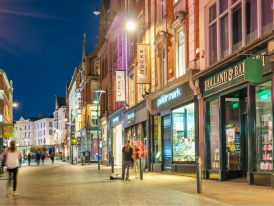
Grafton Street in Dublin city center at night with shoppers walking
Go for the buskers and the energy. This is where names like Glen Hansard and Damien Rice started out. For real shopping, head to Exchequer Street, South William Street, or the Powerscourt Centre, where the mix stays local and interesting.
Temple Bar Prices: Daylight Robbery
Temple Bar has cultural value and a lively atmosphere. Prices, though, are another story. Expect to pay a premium for a pint, often a few euros more than pubs just five minutes away. It is fun once, but your wallet will thank you if you move on after a single What round.

Crowded Temple Bar street in Dublin at night with pubs and cobbled lanes
For vibrant nightlife without the extra cost, try The Stag’s Head on Dame Court for a proper Victorian room or The International Bar on Wicklow Street for comedy nights and an Irish-pubs crowd that feels local.
Museum Overload: Less Is More
Dublin’s museums are excellent, but trying to see them all turns culture into homework. Pick one and give it real attention.
The National Gallery of Ireland tells the country’s story through art. Make time for the National Gallery’s Irish art collection. It is a straight line into the city’s head and heart.
On Kildare Street, the National Museum of Ireland holds archaeology that will stop you in your tracks.
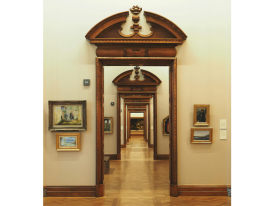
National Gallery of Ireland interior with Irish art on display
Dublin’s museums are excellent, but trying to see them all turns culture into homework. Pick one and give it real attention.
The National Gallery of Ireland tells the country’s story through art. Make time for the National Gallery’s Irish art collection. It is a straight line into the city’s head and heart.
On Kildare Street, the National Museum of Ireland holds archaeology that will stop you in your tracks.
The Hugh Lane Gallery focuses on modern and contemporary work.
One museum per day works best. Check opening hours before you go, and leave space between the big rooms so you can enjoy the city itself.
Dublin's Living Culture: Beyond the Museums
Here is the bit most guidebooks skip. Dublin’s cultural identity lives in the small, daily traditions Irish people still keep. This is a vibrant city where conversation is a sport and wit flies across the bar faster than you can order a pint. Sit still for ten minutes, and someone will rope you into a debate about politics, music, or rugby before you finish your drink.
Tune into those rhythms and you will meet the city’s true character, not the tourist version. That is Dublin’s cultural life in plain view, alive and noisy and impossible to fake.
Literary Dublin: More Than Joyce
James Joyce dominates the tours, and fair enough. Ulysses lives here, and on June 16, Bloomsday still sends people tracing Leopold Bloom’s steps.
But the scene has always been bigger than one genius. Dublin drips with Irish literature. The International Bar runs comedy most nights with fearless new voices. Poetry Ireland lists readings across the city, and Books Upstairs hosts regular launches and conversations that smell of ink and coffee.

Bookshelves and reading room inside the Museum of Literature Ireland, Dublin
Irish emigration shaped what got written here. Joyce left early, and plenty of writers carried Dublin in their heads abroad. The echoes still ring.
If you want it on stage, head to the Abbey Theatre, Ireland’s national theatre. New work and revivals share the bill, proving Irish writing has long punched above its weight on the world stage. The culture never left. It is still being written in back rooms, upstairs spaces, and small shops where the conversation carries on long after closing time.
Beyond the Checklist
Discover the city guidebooks don’t cover with a local by your side.
GAA: Understanding Irish Identity
Gaelic games are about community, language, and place. Even if you do not know the rules, a day at Croke Park shows you something real about Irish identity that no museum can match. Start at the GAA Museum for the backstory, then let the roar on match day explain the rest.

Fans in county colours at Croke Park during a Gaelic football match in Dublin
If you cannot catch a game, book a guided tour on days without matches to see the stadium properly. It is family fun even when you do not know the score, and the scale of the place alone is worth it.
The All-Ireland finals now fall in July, with league and championship games running through spring and summer for easier access.
The Art of Dublin Conversation
Dublin’s greatest cultural export might be conversation. We talk to strangers, test ideas, and trade quick lines the way other cities trade business cards. It is not a show for visitors. It is how we make sense of the world.
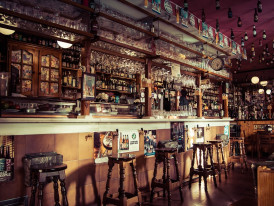
Traditional Dublin pub interior where locals gather to talk and share stories
Join the chat in a traditional pub, with a shopkeeper, or on the DART when the carriage is in good humor. Dublin rewards curiosity and side-eyes pretension, so ask questions, share an opinion, and expect wit in return. More than once, I have found myself debating politics with a stranger at closing time, the whole pub listening in and adding their two cents.
Before You Go, Talk to Someone Who Knows
A local video call helps you plan the trip that’s right for you.
Neighborhood Explorations: Where Dublin Lives
One thing I love about this city is how you can wander through three of the best Dublin neighborhoods in a single day, and each one feels different. The city is small enough to explore on foot, but every area has its own character, history, and local culture. Slow down, take a turn off the main road, and you will find the hidden gems in side streets, markets, and small squares where Dubliners actually live their lives.
The Liberties: Dublin's Authentic Heart
The Liberties is one of Dublin’s oldest neighborhoods, and it wears the years well. You feel the history under your feet. The name comes from medieval jurisdictions outside the city’s control, and that independent streak still runs along Meath Street and Thomas Street.

Medieval Dublin street in The Liberties with red-brick buildings and local shops
This is working in Dublin. It is home to Guinness at St. James’s Gate and the Guinness Storehouse. St. Patrick’s Cathedral stands here, too, along with family businesses that keep the place grounded.
When I want a quieter history hit beyond the center, I head for Newbridge House in North County Dublin. It is a Georgian estate with gardens and space to breathe, a world away from the city noise.
Georgian Dublin: Architectural Glory
Dublin’s Georgian squares are eighteenth-century city planning at its best, all symmetry and light. When Dublin was the second city of the empire, builders laid out terraces that still make you slow your step. Merrion Square, next to the National Gallery and the Natural History Museum, feels as poised as the brickwork around it. These terraces tell the city’s rich history in every line.

Georgian townhouses with iconic colourful doors near Merrion Square, Dublin
The facades carry a complicated story. Anglo-Irish wealth was on display while many locals had few rights. The elegance does not erase that history. Today, many houses serve as offices or embassies, yet the long fall of light across the red brick still works a quiet magic.
Look closely at the doors. Their colors are traditional with a touch of myth, helping people tell one house from another before numbers were standard. It is also how Dubliners keep a bit of personality in a row that wants to match.
Northside Neighborhoods: My Territory
Living in Clontarf gives me serious northside pride. This coastal neighborhood has Victorian seaside charm, the DART on your doorstep, and some of the city’s best coastal walks without the crowds. The promenade runs from Fairview toward Howth, perfect for morning walks or evening strolls.
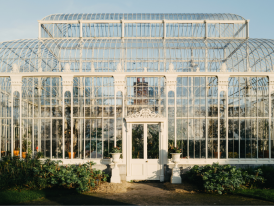
A greenhouse in the National Botanic Gardens of Ireland in Dublin
Nearby Drumcondra and Glasnevin feel like real neighborhoods, with great pubs and quick access to Phoenix Park. The National Botanic Gardens in Glasnevin are free, beautiful, and rarely crowded. I often go there when I want fresh air without trekking miles outside the city.
The northside usually means better value, a more local feel, and easy access to the coast without city center prices. It is where Dublin slows down just enough to let you catch your breath.
Smithfield and Stoneybatter: Creative Dublin
Smithfield and Stoneybatter have kept their working-class backbone while welcoming creative businesses. This is where young Dublin lives. Artists, writers, and city workers come here for a neighborhood vibe. The city’s cultural life hums in the local restaurants, small galleries, and a music scene that feels lived-in rather than staged.
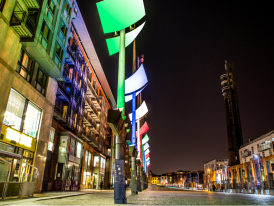
Colorful Smithfield Square at night, where the hip spend their time
The Cobblestone anchors the traditional Irish music sessions. Light House Cinema screens films that challenge and entertain. You will find good value without the tourist markup, which makes this one of the real hidden gems in Dublin for food, shopping, and an authentic neighborhood atmosphere.
Docklands: Modern Dublin's Statement
The Docklands show Dublin’s shift from a fading port to a modern European capital. Love it or hate it, locals are divided. Some see glass towers and big money, others see progress. Either way, the area reflects Dublin’s ambition to stand beside London and Frankfurt as a financial hub.

Samuel Beckett Bridge over the River Liffey with Dublin Docklands skyline
Walk the quays for striking views of the Samuel Beckett Bridge and the skyline. I like the Convention Centre Dublin best from the riverside, where the curves and glass catch the evening light. It is a different face of the city, polished but still Dublin underneath.
Is More Than Its Checklists
From tucked-away eateries to lively markets, discover flavors worth your time.
Howth: Coastal Dublin Magic
Howth flips between a fishing village and a tourist magnet depending on the season and time of day. The peninsula has dramatic coastal scenery, excellent seafood, and hiking that rivals anywhere in Dublin, Ireland, all within 30 minutes of the city center by DART.

Howth cliff path above Dublin Bay with sea cliffs and open water
The cliff walk takes two to three hours, depending on your route and fitness level. In the village, you will find seafood for every mood, from casual fish and chips to fine dining. The harbor is still a working port, which keeps the maritime feel real rather than staged for visitors.
Be smart about the season. Winter winds can make the cliff paths tough, while summer crowds slow everything down. Spring and autumn strike the best balance. That is when Howth proves why it tops the list of worthwhile Dublin day trips.
Interest-Based Dublin: Activities for Every Type of Traveler
Dublin has something for every mood and pace. Whether you are traveling with kids, chasing a hobby, or leaning into a theme, the city serves up family fun, outdoor adventure, and experiences that go well beyond the usual sightseeing list.
This is where you match Dublin to your own style rather than following a script.
Family Fun: Beyond the Obvious
Family fun in Dublin goes well beyond Dublin Zoo (a win if you have kids under ten). Phoenix Park gives little legs space to run and cycle, and with some patience, to spot the wild deer too.
For a bit of magic, try the Malahide Castle Fairy Trail on the West Lawn, then let them tear through the gardens. Head into the Dublin Mountains at Tibradden for marked woodland walks, and if you want a thrill, the Zipit high-ropes course sits right in the trees. When the weather turns, indoor climbing walls keep the energy high. For something playful on land and water, the Viking Splash Tour rumbles through the city before splashing into Grand Canal Dock.

Kids playing in Phoenix Park with wild deer in the background
On rainy days, The Ark in Temple Bar runs arts events for kids, and Explorium in Sandyford is a hands-on science and sports center that reopened in 2024.
Water-mad? AquaZone at the National Aquatic Centre in Blanchardstown has slides, a lazy river, and serious competition pools under one roof.
Practical reality is this. Dublin is compact, but the weather changes fast. Keep a rainy-day backup and you’ll still win the day.
Literary Dublin: Following the Writers
James Joyce dominates the literary tours, and fair enough. Ulysses lives here, and every June 16, Bloomsday still sends readers tracing Leopold Bloom’s steps through the city.
But Dublin’s writing tradition runs far beyond one genius. The Museum of Literature Ireland (MoLI) on St. Stephen’s Green gives a brilliant overview, while the James Joyce Centre and the National Library’s Yeats exhibition add depth for anyone chasing Ireland’s literary soul.
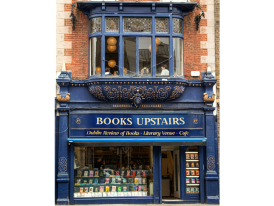
The Books Upstairs Bookshop in Dublin
The Abbey Theatre keeps the stage tradition alive with new work sharing the bill with classics. If you want to walk in Joyce’s footsteps, the tours follow Bloom’s route through real city streets, a reminder that he wrote Dublin even while living abroad.
And for today’s voices? Drop into Books Upstairs, where regular readings showcase writers shaping the next chapter of Irish literature rather than polishing the last one.
Outdoor Adventures: Beyond City Center
The city’s outdoor options run from city center parks to coastal routes and mountain escapes. The Grand Canal and Royal Canal towpaths offer quiet cycling away from traffic. Dublin Bay cycle routes link the city to coastal towns via a mix of paths and on-road sections. For outdoor adventure, you’ll find trails for hiking, cycling, and easy seaside walks. It’s easy outdoor fun across the city and coast.
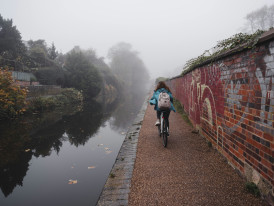
Cycling next to a canal in Dublin in misty weather
Now dublinbikes makes city center rentals easy, while private outfitters cover longer coastal rides. The Wicklow Mountains, the Garden of Ireland, are about an hour from the city by public transportation.
The weather changes fast, so pack waterproofs and keep an indoor backup plan. You’ll enjoy the city more if you leave room to pivot.
Ghost Stories and Folklore: My Specialty
Dublin wears its history on the surface, but it whispers too. The city has ghost stories layered as thick as its cobblestones. Dublin Castle alone has enough tales for a whole evening, a phantom drummer who keeps odd hours, a woman in white said to drift through the gardens, and more if you care to hear them.

Kilmainham Gaol prison cells with dark atmospheric lighting
For a real atmosphere, Marsh’s Library runs after-dark events that make you hear every creak of the floorboards. The Hellfire Club up in the Dublin Mountains mixes wind, ruins, and firelight into something properly eerie. And Kilmainham Gaol? The guides there know how to deliver a story that stays with you long after you leave.
The best Dublin folklore does this one thing: it tucks enough Irish history into the telling that you’re never sure where fact ends and the hauntings begin.
Getting Around Dublin: Transport That Works
Dublin’s compact size makes walking the default in the city center, but knowing public transit gets you to the coast, suburbs, and farther-flung stays without stress or expense.
Dublin Airport: Getting In and Out
Dublin Airport sits roughly 10 kilometers north of the city center, so you’ve got options. Two private coaches, Dublin Express and Aircoach, run frequent buses into town and stop at the big hotels. Aircoach route 700 is the main line most people use.

Exterior of Dublin Airport terminal with Aircoach service parked outside
Taxis run on regulated meters, so check it’s ticking before you set off. Private transfers are easy to book through your hotel if you want door-to-door. On a budget? Dublin Bus routes 16 and 41 also reach the center, though they take longer than the coaches. A Leap Card works on all of them and gives you the best value.
DART and Dublin Bus: Public Transport Reality
The DART runs along the coast from Howth in the north to Greystones in the south with regular service and great views of the bay. I take the DART when I want predictable timings and a seat with scenery. Dublin Bus can be handy, but traffic sometimes wins. A Leap Card works on DART, Dublin Bus, and the Luas. Top it up once and use it everywhere.

DART train running along the coast near Dublin Bay, offering scenic sea views
Walking Dublin: The Sensible Approach
Dublin city center is small enough to cross on foot, about 2 kilometers east to west and 3 north to south. The River Liffey cuts the city in two, a handy north–south marker when you’re finding your way. Wear decent shoes since the sidewalks can be uneven or cobbled, and carry a light waterproof even on bright days. The weather changes fast, and a sudden soak can ruin good plans.
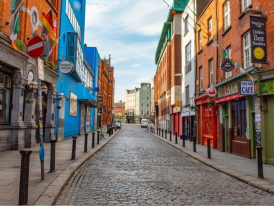
Classic cobbled streets in Dublin
Seasonal Dublin: When to Visit and What to Expect
Dublin’s oceanic climate won’t promise sunshine, but each season brings its own version of the city. Here’s a quick guide to help you plan:
- Summer (June to August): Book central stays early and reserve timed entries for the Guinness Storehouse or Trinity College. Expect long days, festivals, Bloomsday for James Joyce fans, buskers on Grafton Street, vibrant nightlife, bigger crowds, and higher prices. Use the DART for quick coastal escapes.
- Autumn (September to November): Easier bookings and better rates. Expect color in St. Stephen’s Green and Phoenix Park, traditional Irish music in full swing, quieter galleries such as the National Gallery, more rain, earlier sunsets, and strong outdoor adventure without the summer crush.
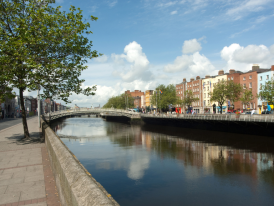
A lively Dublin summer street scene
- Winter (December to February): Aim midweek for cheaper hotels. Expect Grafton Street lights and markets, quiet museums, cozy pubs, frequent rain, and short days that suit indoor plans such as museum visits or whiskey tastings.
- Spring (March to May): Book early if you want St. Patrick’s Day. Parks and canals wake up, deer roam Phoenix Park, markets restart, canal walks brighten, and crowds stay light until summer returns.
More than 26,119 5-star reviews and counting
26,119+ 5-Star Reviews and Counting
Trusted and recommended by travelers worldwide.
Frequently Asked Questions on Things to Do In Dublin
- Is Dublin expensive to visit?
- Yes. It’s one of Europe’s pricier cities. Save with lunch specials, early-bird menus, free museums, and pubs outside Temple Bar.
- How many days should I spend in Dublin?
- Three to four days cover the top sights and a couple of neighborhoods. Add one or two if you want day trips.
- What’s the deal with the Guinness Storehouse?
- Touristy but worth it. Book ahead and go early or late. The Gravity Bar view sells it, then compare that pint with one in a neighborhood pub.
- Is Temple Bar worth visiting?
- Yes, for a look and a single round. Prices run higher than pubs five minutes away. For value, drift to nearby streets.
- Can I walk everywhere in Dublin?
- In the city center, mostly yes. It’s compact. Wear good shoes and pack a light waterproof. Use the DART or Dublin Bus for the coast.
- When is the best time to hear traditional Irish music?
- Year-round, with autumn and winter strongest. Try The Cobblestone or O’Donoghue’s and arrive early for a seat.
- Is Dublin good for families?
- Yes. Phoenix Park, Dublin Zoo for under-10s, coastal walks, and rainy-day options like AquaZone and The Ark.
- What should I pack for Dublin’s weather?
- Layers, a waterproof jacket, and comfortable shoes. The weather changes fast. A small umbrella helps.
- Do I need to book attractions in advance?
- For Trinity College and the Book of Kells, and the Guinness Storehouse, yes. Free spots like the National Gallery and the Chester Beatty Library usually do not.
- Is Dublin Castle worth a visit?
- Yes. Do a guided tour to see Viking foundations and the medieval Dublin layers, then pop into the Chester Beatty Library next door.
- What’s the best way to get around Dublin?
- Walk in the center. Use a Leap Card on DART, Dublin Bus, and Luas for everything else.
- What day trips can I take from Dublin?
- Howth for cliff walks and seafood, the Wicklow Mountains for hikes, and Glendalough for monastic ruins. All are doable by public transport.
- Can I visit Dublin’s museums for free?
- Yes. Many are free, including the National Gallery and parts of the National Museum of Ireland. The Chester Beatty Library is free as well.
- Is Dublin safe for tourists?
- Generally yes. Use normal city smarts, especially at night in crowded areas like Temple Bar.
- How much should I tip in Dublin?
- In restaurants, 10–15% for good service. Round up for taxis. No need to tip for each drink at the bar.
Your Dublin Adventure: Final Thoughts From a Local
After 35 years in this mad, beautiful city, I’m still stumbling on new corners, overhearing lines that make me laugh, and being caught off guard by how Dublin can be ancient and modern, traditional and innovative, intimate and international, all at once.
Dublin isn’t perfect. It’s pricey, often wet, and sometimes heaving with visitors who miss the real charm. But it’s magical in ways guidebooks never quite capture.

The River Liffey and Ha'penny Bridge illuminated at night, with reflections
This is a place where James Joyce still seeps into daily chat, where traditional Irish music sessions pull strangers into the same rhythm, and where a properly poured pint teaches you the value of patience. You can walk from Dublin Castle’s medieval stones to the modern Docklands in twenty minutes and feel centuries of history under your feet.
Whether it’s the literary legacy, the wild sweep of Phoenix Park, family fun in the city center, or just plain curiosity, the best things here reward people who come to listen as much as look.
We’re friendly, not saints. We’ll talk your ear off, pour you an honest pint, argue about everything under the sun, and most nights invite you back tomorrow to finish the conversation. And if Dublin leaves you wanting more, it’s the perfect gateway to unforgettable Ireland experiences beyond the capital.
Keep Exploring Dublin
Ready to Plan Your Perfect Day in Dublin?
Start your experienceWhat If Your Day in Dublin Was Planned by Someone Who Knows It, and You?
City Unscripted matches you with a local host who creates a private experience based on your interests, not a set route.
Want to Experience the Real Dublin with Someone Who Lives There?
A fully private experience, planned and led by a local host who tailors the day to you
